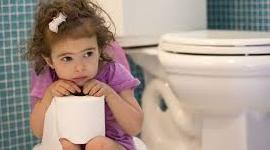 BACKGROUND: Potty training is a developmental milestone that can be overwhelming for children, caregivers, and educators. Children begin potty training at different ages, follow different training processes, and often have setbacks such as accidents, constipation, and regressions. It is important for caregivers and educators to offer a consistent routine and recognize children’s successes (American Academy of Pediatrics, 2017; Greer et al., 2016). We present signs that children are ready to begin potty training and strategies for success.
BACKGROUND: Potty training is a developmental milestone that can be overwhelming for children, caregivers, and educators. Children begin potty training at different ages, follow different training processes, and often have setbacks such as accidents, constipation, and regressions. It is important for caregivers and educators to offer a consistent routine and recognize children’s successes (American Academy of Pediatrics, 2017; Greer et al., 2016). We present signs that children are ready to begin potty training and strategies for success.
Signs of readiness
- Consider the child’s age since most children are ready to begin potty training around 18-30 months
- Consider the child’s developmental skills including ability to pull pants up/down independently and communicate the need the use the bathroom
- Consider the child’s interest, such as asking questions about the potty and acknowledging own wetness or bowel movement
Strategies for success
- Gather materials such as a timer, paper and pen for notes, pull-up or underwear and elastic waist pants, and set the environment for success by introducing a child potty and toys to enhance self-help skills
- Develop a consistent routine, such as child sets and turns off timer, dresses self after toileting
- Provide regular support and reassurance, praising the child for attempts and progress
- Adjust routines to respond to children who are not showing success over time, such as adding more frequent attempts, wearing underwear, or reading books about going potty
APPLICATION: In the scenarios below, Dilshad supports children’s potty training routines.
In the infant and toddler room two toddlers, Camille and Johnny, were showing signs of interest in potty training by watching their older peer who was already potty trained. Dilshad encouraged this interest and started to incorporate self-help skills into the curriculum. The teachers adapted the classroom environment by setting out clothes for baby dolls and scaffolding the toddlers’ attempts to put shoes and clothes on the babies. Camille, a 2-year-old, was able to independently dress the babies and could apply the self-help skills to undress and dress herself. Camille’s parents talked to Dilshad about developing a potty training routine and started potty training at home one weekend. Dilshad consistently implemented the routine at school by using a timer every hour to remind Camille and the other teachers that it was time for Camille to try going potty. As Camille was able to go longer periods of time without having accidents, Dilshad gradually increased the time each day. Soon Camille reached a point when she was verbally able to tell teachers when she needed to go potty.
Johnny, 2.5-years old, began potty training at the same time as Camille and also used a timer as part of his potty training routine. However, after a few weeks of successful potty training with Camille, he began to regress. Johnny was spending many minutes in the bathroom struggling to remember what to do next. Dilshad kept a record of which self-help skills seemed difficult for Johnny and which parts of the routine he was forgetting. Dilshad created a book that Johnny could use as a reference and visual cue to help him with the sequence of steps of potty training. Dilshad adjusted Johnny’s routine by saying, “Johnny, let’s look at the book together and turn each page when you have completed working on that step.” Johnny and Dilshad consistently followed this routine, and Dilshad reassured Johnny that he was working hard and making progress. In three months Johnny was successfully wearing underwear.
TO LEARN MORE:
Accidents After Potty Training
American Academy of Pediatrics
Mayo Clinic
REFERENCES:
American Academy of Pediatrics (2017). Practicing safety: Toilet training. Retrieved from http://www.aap.org/
Greer, B.D., Neidert, P.L., & Dozier, C.L. (2016). A component analysis of toilet-training procedures recommended for young children. Journal of Applied Behavioral Analysis, 49, 69-84.
Potty Training with Young Children
Other Resources
https://www.healthychildren.org/English/tips-tools/ask-the-pediatrician/Pages/Are-accidents-normal-or-the-sign-of-a-problem.aspx
https://www.healthychildren.org/English/ages-stages/toddler/toilet-training/Pages/default.aspx
https://www.mayoclinic.org/healthy-lifestyle/infant-and-toddler-health/in-depth/potty-training/art-20045230
https://www.aap.org/en-us/Pages/Default.aspx
https://crane.osu.edu/files/2020/01/Potty-Training-with-Young-Children.pdf

